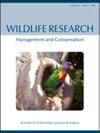Kinship analysis reveals low dispersal in a hog deer (Axis porcinus) population in Wilsons Promontory National Park, Australia
IF 1.6
3区 生物学
Q3 ECOLOGY
引用次数: 1
Abstract
ABSTRACT Context A wild population of non-native hog deer has established in the Gippsland region of Victoria, Australia, and there is particular concern about its impact on native vegetation in Wilsons Promontory National Park (WPNP). Since 2015, there has been annual culling of hog deer at WPNP to reduce deer abundances and impacts. Aim The aims of this study were to use a kinship approach based on genotyping to assess contemporary dispersal of hog deer across WPNP, by identifying close kin, to determine whether dispersal of deer into culled sites from unculled sites may affect the long-term success of management there. Differences in the dispersal of male and female hog deer were also investigated. Methods In total, 91 hog deer tissue samples were collected across WPNP and surrounding sites. Single nucleotide polymorphism (SNP) markers were sequenced, and a final dataset comprising 8275 SNPs was used for analysis. First-order, second-order, and intermediate relative pairs were identified, and the geographic distance between these pairs was assessed to determine inter-pair distances to infer dispersal. Spatial autocorrelation between male and female samples was evaluated to measure the effects of sex-biased dispersal. Key results Only seven second-order relative pairs were found across different sites, with a 30 km distance between the furthest pair observed. However, most inter-pair distances across sites were ~5–10 km. Analyses of sex-biased dispersal showed that movement by deer was not strongly influenced by one sex. Conclusions Although hog deer in WPNP are genetically similar, most relatives that were sampled were not widely dispersed. This suggests that there is limited dispersal of hog deer across this park. Implications Recolonisation of hog deer at culled sites via dispersal is likely to be infrequent in WPNP. Kinship analysis provides an effective method of assessing contemporary dispersal and could be applied to other species to assess fine-scale movement across landscapes.亲属关系分析表明,在澳大利亚威尔逊海岬国家公园的猪鹿(Axis porcinus)种群的低分散
摘要背景在澳大利亚维多利亚州吉普斯兰地区建立了一个非本地野猪鹿野生种群,其对威尔逊海岬国家公园(WPNP)本地植被的影响引起了人们的特别关注。自2015年以来,WPNP每年都会扑杀猪鹿,以减少鹿的丰度和影响。本研究的目的是利用基于基因分型的亲属关系方法,通过鉴定近亲,评估猪鹿在WPNP地区的当代扩散,以确定鹿从未被淘汰的地点扩散到被淘汰的地点是否会影响该地区管理的长期成功。研究了公、母猪鹿的分布差异。方法在WPNP及周边采集91份猪鹿组织标本。对单核苷酸多态性(SNP)标记进行测序,并使用8275个SNP的最终数据集进行分析。鉴定了一级、二级和中间亲缘关系对,并评估了这些亲缘关系对之间的地理距离,以确定亲缘关系对之间的距离,从而推断扩散。评估了男性和女性样本之间的空间自相关性,以衡量性别偏倚分散的影响。在不同的地点只发现了7个二阶相对对,最远的对之间的距离为30公里。然而,大多数站点间的对间距离为~5 ~ 10 km。性别偏倚分散分析表明,鹿的运动不受性别的强烈影响。结论尽管WPNP中的猪鹿具有遗传相似性,但大多数样本的亲缘关系并不广泛分布。这表明猪鹿在这个公园的分布是有限的。在WPNP中,通过扩散在被扑杀地点重新定居的猪鹿可能并不常见。亲缘关系分析提供了一种有效的评估当代扩散的方法,可以应用于其他物种来评估景观间的精细迁移。
本文章由计算机程序翻译,如有差异,请以英文原文为准。
求助全文
约1分钟内获得全文
求助全文
来源期刊

Wildlife Research
生物-动物学
CiteScore
4.30
自引率
15.80%
发文量
56
审稿时长
3 months
期刊介绍:
Wildlife Research represents an international forum for the publication of research and debate on the ecology, management and conservation of wild animals in natural and modified habitats. The journal combines basic research in wildlife ecology with advances in science-based management practice. Subject areas include: applied ecology; conservation biology; ecosystem management; management of over-abundant, pest and invasive species; global change and wildlife management; diseases and their impacts on wildlife populations; human dimensions of management and conservation; assessing management outcomes; and the implications of wildlife research for policy development. Readers can expect a range of papers covering well-structured field studies, manipulative experiments, and analytical and modelling studies. All articles aim to improve the practice of wildlife management and contribute conceptual advances to our knowledge and understanding of wildlife ecology.
Wildlife Research is a vital resource for wildlife scientists, students and managers, applied ecologists, conservation biologists, environmental consultants and NGOs and government policy advisors.
Wildlife Research is published with the endorsement of the Commonwealth Scientific and Industrial Research Organisation (CSIRO) and the Australian Academy of Science.
 求助内容:
求助内容: 应助结果提醒方式:
应助结果提醒方式:


